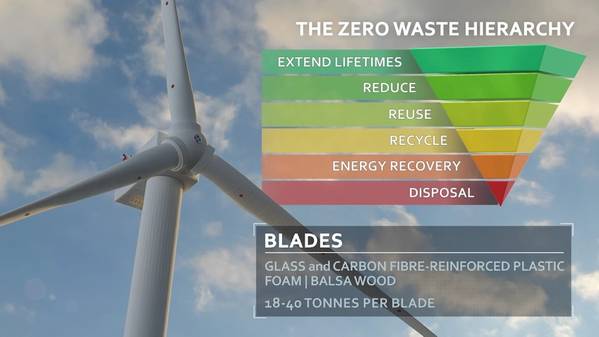
"At-scale recycling of wind turbine blades is an important first step towards achieving a zero-carbon, zero-waste offshore wind industry and boosting the UK supply chain by 20,000 jobs, " the UK-based Offshore Renewable Energy (ORE) Catapult said in a report Wednesday.
The ORE has called for increased investment and a radical shift in research and development into wind turbine blade recycling, citing the huge economic opportunities for the UK supply chain from a circular economy approach in offshore wind that could extend the sector’s UK job creation targets by a third, creating an extra 20,000 jobs.
Technically, ORE Catapult said, wind turbines are almost 85-90% recyclable, but their blades, made from composites of resins and fibers, have proven challenging to break down, process, and recycle, and remain the major hurdle to achieving fully recyclability.
According to a report which ORE Catapult produced in partnership with OGTC, and with input from experts at the National Composites Centre (NCC) and the University of Leeds, 14 technologies show promise for recovering blade materials but "further work was needed before we see them deployed at scale, particularly around issues of environmental impacts, energy use and cost-efficiency of techniques such as pyrolysis (heat treatment of composites)."
"This provides a golden opportunity for UK companies to provide solutions for our recycling needs. It is estimated that the global offshore wind industry will need to decommission 85GW of capacity (including 325,000 blades) by mid-century. While these estimates assume today’s 25-year lifecycle, they give an illustration of the scale of the future global market for circular economy pioneers in the sector," ORE Catapult said.
Other key findings of the report titled ‘Sustainable Decommissioning – Wind Turbine Blade Recycling’ include:
Chris Hill, Director of Operational Performance at ORE Catapult, said: “As the report makes clear, we are on the cusp of a break-through composites recycling solution. The technologies exist, but to be viable, they require intensified investment and some new approaches to studying and addressing the remaining innovation challenges. Engagement with the UK supply chain is the first step for us: recycling is only of benefit when the recovered materials have saleable end-products that prevent deployment of virgin materials.”
"Wind industry manufacturers and operators are beginning to set ambitious targets for achieving zero waste turbines within the next twenty years. There is also an active hotbed of research into lifetime extension of turbines, pushing towards 40-year lifetimes, as well as exploring alternative materials to composites. Recycling these first-generation blades is the first step in achieving zero waste, and as the report highlights, it can also be a stepping-stone to a spin-off circular economy.”
Dr Anne Velenturf, a Research Impact Fellow at the University of Leeds who is leading research on a circular economy for offshore wind with the ORE Catapult, added: “A high-value circular economy, in which wind turbines are designed for durability and for repair, reuse and remanufacturing ahead of recycling the materials, has a high potential to minimize carbon emissions and to open new business opportunities for companies in the UK, creating thousands of jobs in our communities.”
ORE Catapult said that the next phase of the project will assess and appraise glass fiber recycling processes in order to identify the “best” potential solutions for further study and demonstration.
"ORE Catapult has targeted an at-scale demonstration of blade recycling in the UK within the next five years through both the ETA Blade Recycling Project and a new joint industry project Circular Economy in the Wind Sector (CEWS). ORE Catapult is keen to support offshore wind supply chain SMEs, manufacturers, owners and operators as they strive towards creating a circular economy for the wind sector," ORE Catapult said.